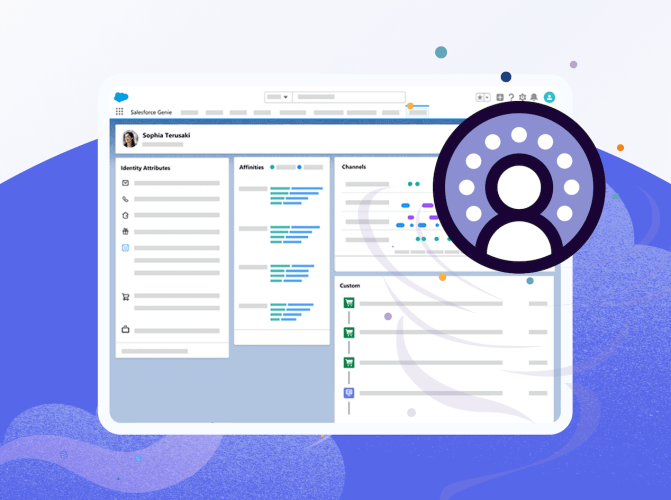How to Lock Your Digital Door: Data Privacy Best Practices in 2024

Data privacy is not an afterthought in the age of AI. Learn how to safeguard your company's peace of mind.

Amanda Lane
Data takes center stage in building trust. However, stories about data loss can steal the spotlight – and be reputation killers. Safeguarding against such risks requires a proactive approach: with strong data privacy, governance, and precaution.
The outcome? Sensitive customer data stays private, and customers stay satisfied.
It’s important to note that data privacy is different from data security. The latter revolves around securing information against bad actors with cybersecurity tactics like encryption, threat monitoring, and two-factor authentication. It safeguards the integrity and trustworthiness of the information.
Data privacy, another branch of data protection, deals with the appropriate management (sharing or collecting), handling, storage, and utilization of personal information, with an emphasis on regulation.
Protect your data to protect your dollars
Learn trends in global security so you can stay agile as a leader. See how 300+ IT experts put real-time insights to work in our free research report.

Why is data privacy important?
In today’s AI boom, businesses are recognizing that data fuels the digital engine of best-in-class customer experiences.
Yet this realization is also stirring a wave of concerns among customers about how companies store, handle, and share their data. Fortunately, strong data privacy practices foster and maintain trust.
The core of any data privacy measure should demonstrate your commitment to customer privacy rights. Customers expect businesses to respect their privacy preferences – and by not doing so, can result in reputational damage and loss of customer loyalty.
It’s also vital as a preventative measure. Rules, regulations, and best practices exist for a reason: to help mitigate the damage that can happen to companies who lack appropriate safeguards.
Beyond negative customer impressions, violating data privacy regulations can come with a more direct cost in the form of fines. Consider the healthcare industry, for instance.
HIPAA violations can result in civil monetary penalties of up to significant monetary fines per violation, and criminal penalties can potentially involve fines and imprisonment.
How to protect customer choices in data privacy
Data privacy involves an individual’s ability to control how and when their data is used, as well as the ability to choose whether or not they’d like to share their data with a certain company. For businesses, data privacy involves the approach, processes, and perspective to allow for proper compliance.
This can mean:
- Allowing customers to opt in or opt out of sharing data
- Providing transparency about the ways customer data will be used and distributed
- Limiting the amount of data collected and retained to only the crucial information that will help achieve a stated intent
These practices form the cornerstone of a robust data privacy strategy. By respecting customer choices, transparency in operations, and collecting data sensibly, businesses can uphold data privacy while building lasting relationships with their customers.
Top 5 data privacy best practices for building customer trust
There are five key considerations for companies when it comes to data privacy. Each best practice helps ensure the confidentiality and compliance of customer data.
- Consent. Customers are becoming leery of companies that store and sell their data without their full grasp on the give and take. Regulations around consent are also tightening. Both trends point to one thing: Companies need to clearly spell out their intentions with customer data and give customers legitimate options to opt in or out.
- Purpose Limitation. Purpose limitation dictates that companies should follow regulatory guardrails around how data is collected, and compile it only for specified, explicit, and legitimate purposes. Common examples include user opt-in and opt-out forms, so users can choose their preferences.
- Data Minimization. In order to protect customer data, companies need to have strong data management practices. Just as companies shouldn’t use data for unspecified purposes, they also shouldn’t collect data that is not relevant to their stated purpose. And they should store data only as long as it takes to fulfill that purpose. One way to take action on this is to delete old or stale data.
- User Rights. Users have certain specified rights, some of which are protected by local law and some of which are protected by regulatory entities. You may have even seen some examples in the U.S. with the Federal Trade Commission (FTC), the General Data Protection Law (GDPL) in Brazil, or the ripple effect of GDPR and Digital Operational Resilience Act (DORA) across businesses in Europe. It’s important to familiarize your organization with the laws that apply – tracking developments as state, federal, and global legislators continue to push for more regulation — and configure data privacy practices accordingly.
- Anonymization. A thread that runs through all data privacy best practices is protection. In particular, a key pillar in this process is protection through anonymization. This technique safeguards privacy by modifying or removing specific details from personal data, making identifiers indiscernible without additional information. This allows compromised data from being traced back to a specific user, even in the event of a security breach.
Overcoming key data privacy challenges to future-proof your business
And remember, building a proactive and resilient data strategy allows for a more worthwhile and long-standing relationship with your customers.
Improving data privacy means taking into account the best practices detailed above. But it also means understanding the full scope of issues that can lead to poor data privacy, and appropriately accounting for each.
Here are some common data privacy hurdles:
- Cost. It costs significant money to invest in data privacy. But the alternative — including breaches, fines, and reputational damage — can amount to much more.
- Visibility. When data isn’t organized, it becomes difficult to comply with regulations and best practices. Establish clear protocols for proper documentation, categorization, and audits to provide clarity in the context of regulatory standards.
- Culture. In many organizations, there are still remnants of a previous attitude in which more data was always better. As companies take a more thoughtful approach to data collection and privacy, they’ll need to make sure their people and culture are on board.
- Scope of regulation. It’s extremely challenging for businesses to stay current with all the data privacy regulations under which their company falls. Setting in motion sound processes, such as keeping up with the latest legislative efforts, will help stay in compliance and plan for future changes.
- Hardware diversity. Customers are increasingly interacting with businesses across multiple touchpoints, including smartphones, laptops, tablets, and more. This creates a heavier responsibility on companies as they look to ensure security and compliance across the entire spectrum. Foster collaboration between IT, security, and customer service departments to create a holistic approach to data privacy and to mitigate risks.
Because data privacy brushes up against so many sections of the business, it can’t be treated as an afterthought. The buy-in needed across various departments also shows how a comprehensive data privacy strategy runs parallel to an organization’s greater data strategies and goals.
Artificial intelligence creates urgent call for data privacy
The growth of generative AI – in particular its use of copious amounts of data – created an urgency for data privacy. As the volume and complexity of data handled by AI systems continue to surge, likewise the need to protect sensitive information. And nearly 9 in 10 (87%) analytics and IT leaders agree: advances in AI make data management a higher priority.
It’s possible that this AI spark – if not used appropriately with data safety and customer trust in mind – can catch the foundation of business operations on fire.
As a result, businesses should not only consider the urgency of data privacy frameworks, but strategically think about a data privacy strategy that takes into account key aspects like data protection, ethical AI practices, and transparency.
Though AI has the potential to transform the way companies operate, it’s as essential to place precautionary buffers to avoid compromised data. By doing so, organizations can build AI initiatives for both internal operations and customer interactions with confidence.
How to pick the best data privacy management tools that align with your goals
A company’s industry will often dictate the type and complexity of the data collected, so it can be helpful to work with vendors who have deep experience in your specific type of work.
You’ll also want to keep in mind geography. Because data privacy laws are regional, it helps to have a vendor vigilantly up to speed on the global requirements of data privacy.
Finally, companies should take into account the features available in their data privacy management software. This includes the accessibility of the tools across systems and devices, the data discovery and management capabilities, risk assessment tools, customer consent controls, and more.
By weighing in all these factors, businesses can build partnerships that smoothly navigate the intricacies of data privacy and teach them to thrive in a culture where data isn’t just a commodity, but a responsibility.
Transform your team’s data culture
Data is not just a nice-to-have. It’s a crucial teammate that closes the loop from insight to action. Learn how to put data at the center of every decision.































